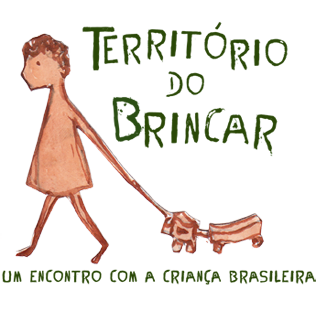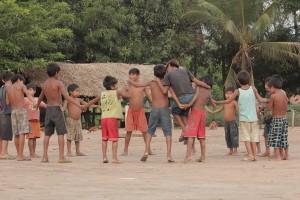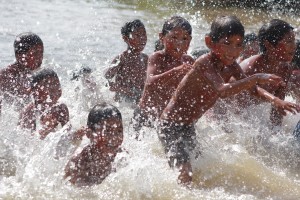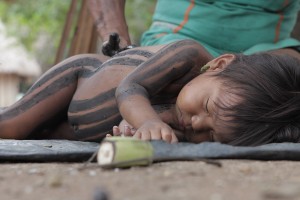May-2015
The Panará and their children
Recent linguistic and ethnic-historical data show that the Panará of Peixoto Azevedo/sources of the Iriri River are the last descendants of a much larger group, better known as the Caiapó do Sul, that occupied the region between northern São Paulo, southern Goiás, eastern Mato Grosso, southeastern Mato Grosso do Sul and the triangulo mineiro region during the 18th century. There were many conflicts during this time as a result of the process of occupation by colonizers driven by the presence of gold in the region. There are records that point to the presence of thousands of Caiapó do Sul still in the 18th century, but offensives against them by the government resulted in the near disappearance of these people from this region and in a migration to denser forests in northern Mato Grosso during the 19th century.
If the hypothesis that the Caiapó do Sul were in fact the Panará is correct, maybe one can relate this to stories told through the oral tradition by their elderly. The Panará say they came from the east, a region of hilly fields populated by ipen (whites or other people in the Panará language), with whom they had frequent conflicts, and from there they migrated to the Peixoto de Azevedo River region (a tributary of Teles Pires River, a main tributary of the Tapajós River in northern Mato Grosso), crossing three large rivers in the process. In this place they found peace and prosperity. There they built a village called Atuiasâ, possibly in the beginning of the 19th century, where many children were born and they were able to grow their population. Once their population grew, the Panará separated into new villages, spreading through the region, coming into new conflicts with other indigenous nations, and facing the event that would forever mark the life of these people: the construction of the BR-163 highway, which cut through the middle of the territory they occupied.
The Brazilian government decided to build this highway in the 1970s, despite knowing about the presence of the Panará, with the intention of connecting the mid-west region to the northern region of the country, drawing a highway that goes from Cuiabá, in Mato Grosso, to Santarém, in Pará, and they called the Villas Boas brothers to pacify the natives and remove them from the construction areas. The Panará, frightened by the presence of tractors and contact groups, escaped and avoided contact from the whites for four years. However, indirect contact with whites via presents left by the contact group or from proximity to construction workers was enough for the Panará to contract diseases they did not know and could not treat, leading to a drastic wave of deaths that once again reduced their population. It is estimated that of the 400 Panará living at that time, only 74 remained when they surrendered to contact in 1973. The oldest recall that people were dying so quickly they did not have time to bury their dead.
Upon seeing the Panará’s grave situation, the Villas Boas brothers decided to transfer them to the Xingu Indigenous Park in 1975. The Panará left the land of their ancestors, leaving their farms and villages behind. Once at the park, they moved villages many times and could not adapt, had almost no children, people kept dying, and they could not get used to the new ecosystem, which was unfamiliar to them and did not have the resources they were used to using. They always dreamt of the land they left behind, and from there was born a great desire and a movement to reclaim their land of origin.
So the Panará mobilized important partners that helped them reclaim their territory. With the first expeditions came a sad realization: the whites had consumed their land. The site of the largest Panará village had become the municipality of Matupá, and many other villages had given place to the formation of urban areas. However, they found one preserved area near the sources of the Iriri River, with forest, a river, and game, enough conditions to give them hope of returning to their territory. They then engaged in a great fight and in 1996 convinced the government to demarcate approximately 490 thousand hectares of land, creating the Panará Reservation.
They left the Xingu Park and moved to the Panará Reservation, where they once again found peace and prosperity, and in 16 years have nearly tripled their population. From the 183 that arrived at the Panará Reservation, there are now approximately 500, 75% of them below the age of 18. There are many, many children in Nãsêpotiti. Discovering their children’s games showed us the vitality of Panará culture, and how an ancestral flame can be kept alive despite the historical adversities they faced. The games have traces of Panará knowledge and history: the link to when animals were people, the wars with other nations, the constant imitation of the practices of the adults, the use of natural resources to make toys, and the small-scale (re)creation of everything they see around them.
Text: Paula Mendonça
Sources:
Website – Indigenous Peoples of Brazil
Reports:
MENDONÇA, Paula. 2006. Oficina Temática: História do Território Panará. Instituto Socioambiental.
MENDONÇA, Paula. 2010. Expedição: Aldeias Antigas Panará. Instituto Socioambiental.
JUNQUEIRA, Paulo. 2012. Expedições aos sítios históricos dos povos indígenas Ksêdjê, Panará, Kawaiwete e Yudja. Instituto Socioambiental/ IPHAN.
. 1









Leave a Reply